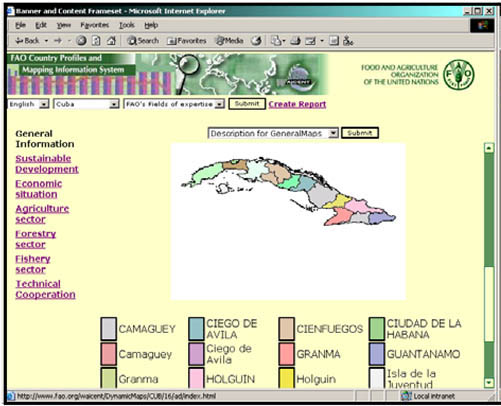In this section we present an example of the Country Profiles application [15] used as a case study for our approach. Country Profiles is an application in the FAO that allows access to country-specific information without the need to search individual databases and systems. It is an information retrieval tool that groups in a single area the vast amount of information available at FAO based on the global activities in agriculture and development, and classifies the information by country. The application uses three categories to group information:
(1) FAO’s areas of expertise - sustainable development, economy, agriculture, fisheries, forestry, and technical cooperation,
(2) FAO’s priority areas for interdisciplinary action (PAIA)- ranging from biological diversity to trade in agriculture, fisheries, and forestry, and
(3) AGROVOC - a metadata ontology with over 4000 terms breaking down the first two metadata categories to a lower level (i.e. Cattle Breeding). AGROVOC is mainly used in the Library applications at FAO.
We have developed the Country Profiles application by using Web service technology. Figure 7 presents the web page used as the interface to the application. In Figure 7 it is possible to see all the different services used in the application.
Firstly the three dropdown lists under the banner at the top of the page are invoked from the support Web services described above. These set the state of the application and are currently set to English (EN), Afghanistan (AFG) and FAO’s Fields of Expertise for the metadata. The categories to the left of the page (General Information) are also populated from the same metadata support Web service. Slightly below is the fourth dropdown list, this is populated using the relevance service, which takes inputs from the above three services and generates a list of available Web services which meet the current state of the application. It also contains the exact parameters to be sent to each content service when the user chooses an application (see Figure 6 for an example). Finally in the main body of the screen you can see an example of an invoked content Web service, in this example the service returns News information about the selected country from a system names EIMS.

Figure 7: Example of the web page for the Country Profile application


Figure 8: Screenshots of the Country Profile application
Figure 8 shows examples of another content service being invoked (in this case the information in derived from the General Mapping application). Images are received in the body of the XML response as Base64 encoded string, which is decoded and cached on the client application server for faster retrieval. Legend text is also sent with the encoded string and the colors are generated using hash codes (e.g. #FFFFCC). The second screenshot in figure 8 shows a generated report in PDF format (see subsection 4.2).